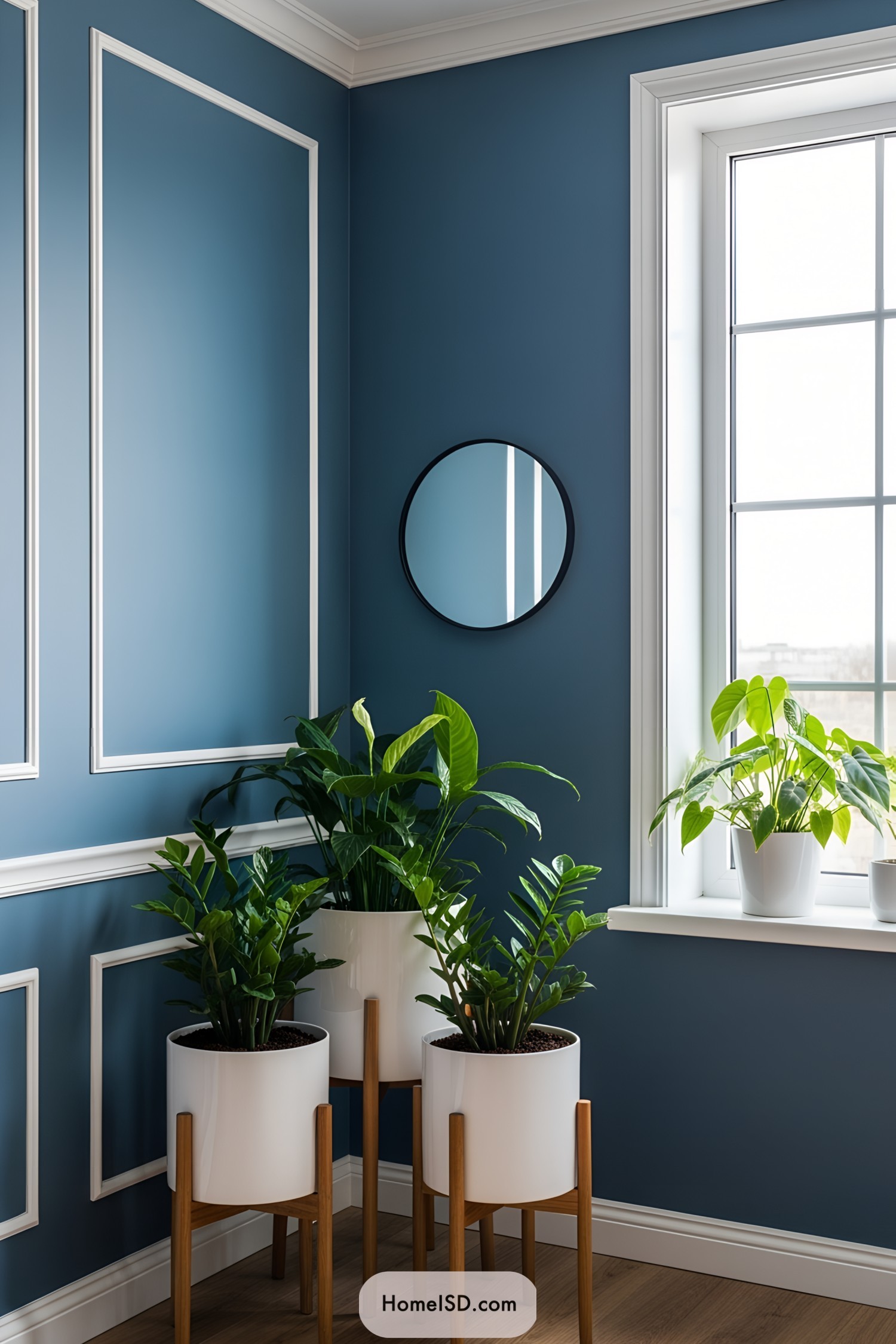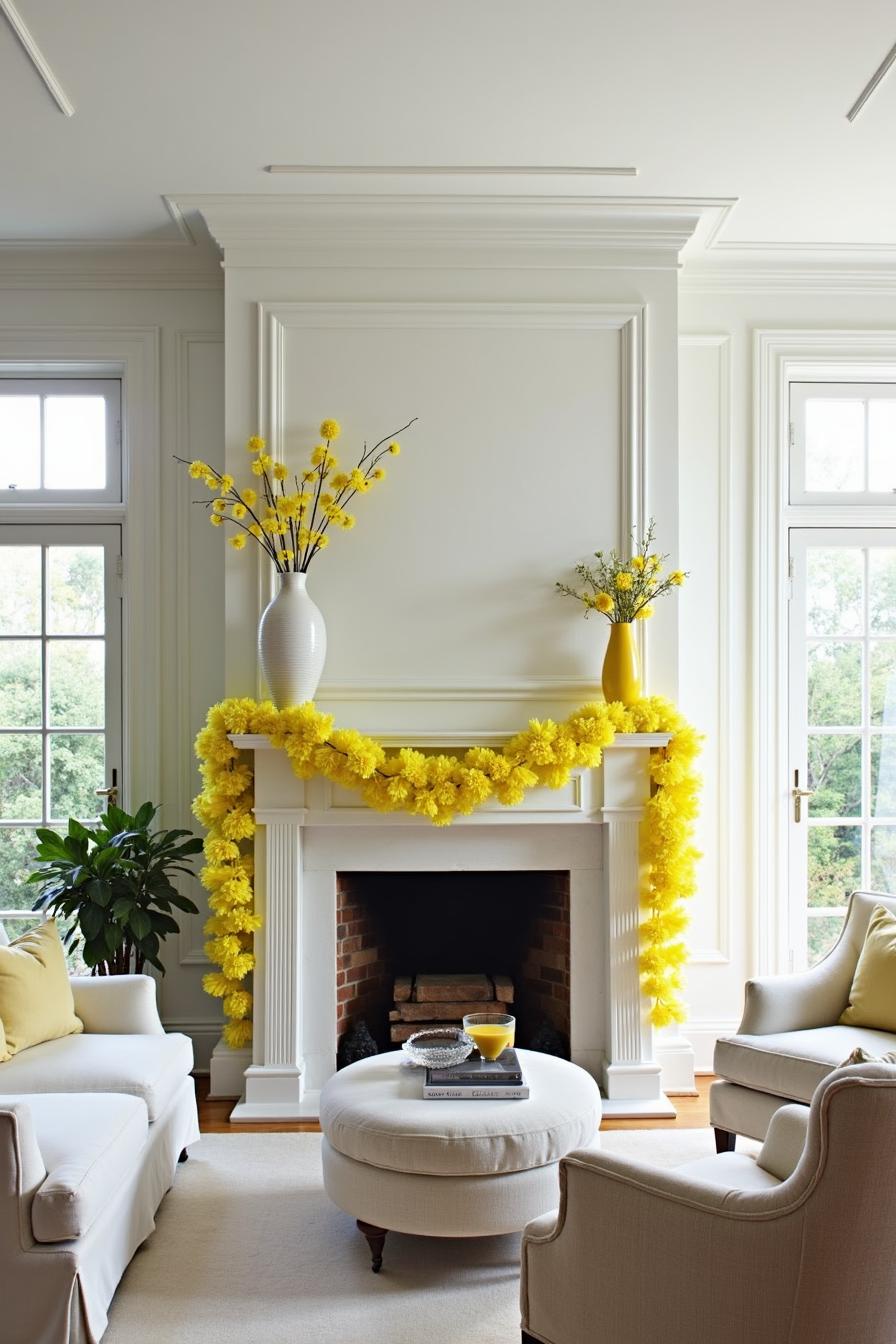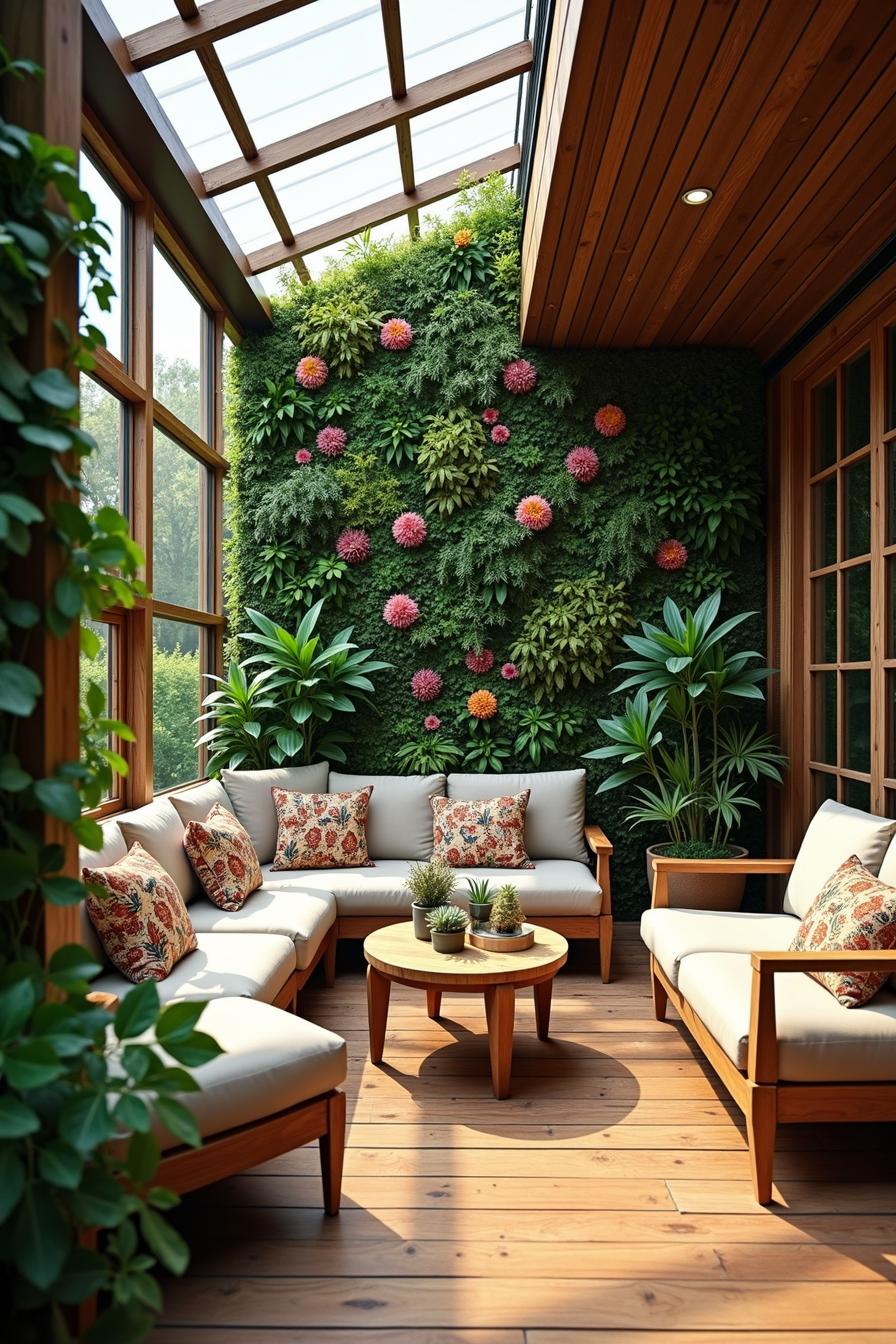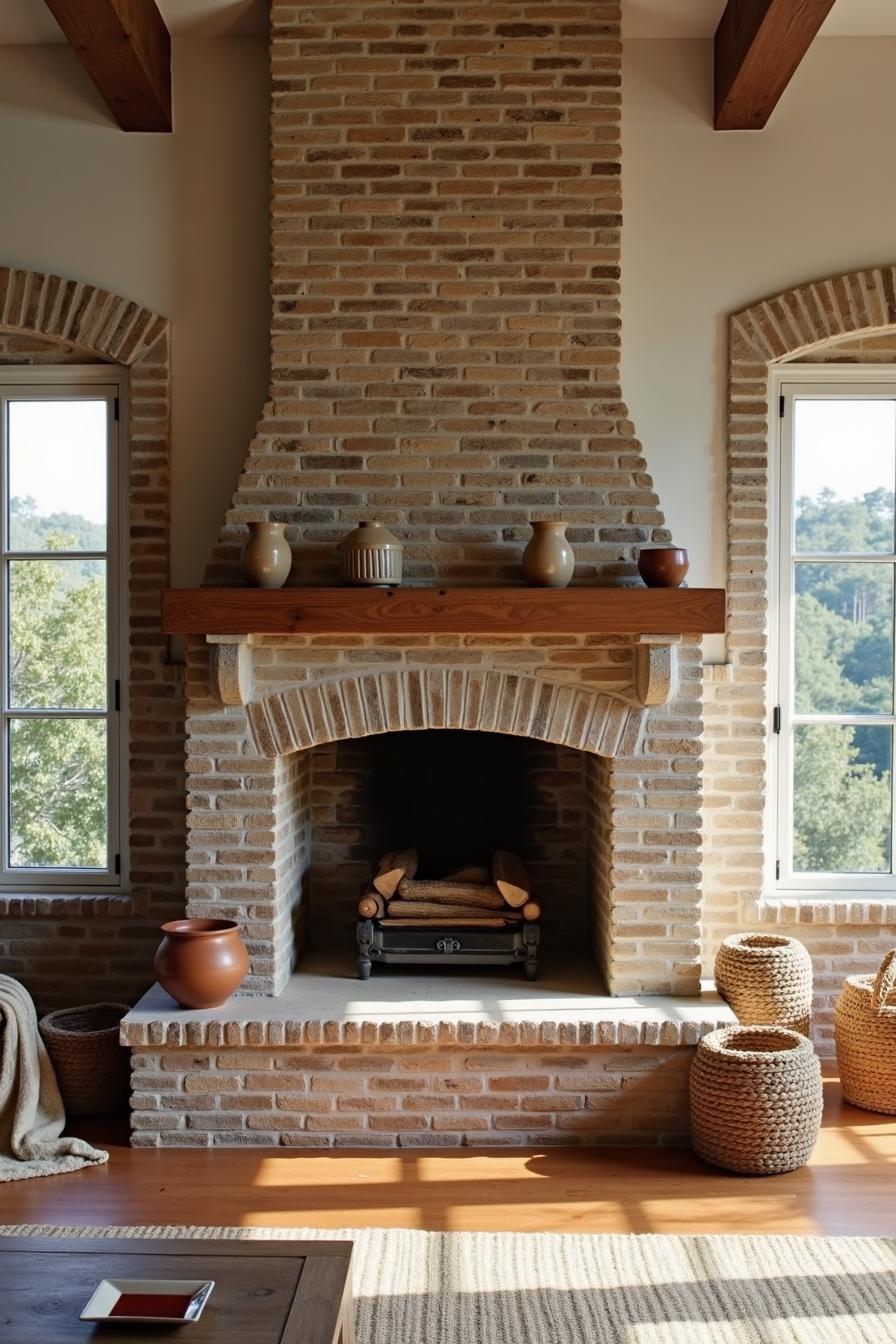Last updated on
Dive into the captivating world of aquascaping because these creative ideas will transform your aquarium into a breathtaking underwater paradise.
I’m proud to have penned this article and created 20 unique aquascaping designs, and I sincerely hope you find them as inspiring and enjoyable as I found creating them.
Dive into the world of aquascaping, where imagination meets underwater design.
Here, you’ll find innovative ideas to transform your aquarium into a breathtaking aquatic landscape, all while staying within budget.
From selecting the right plants and rocks to choosing the perfect fish species, every detail is covered.
Whether you’re a beginner or a seasoned aquarist, these tips will help you create a stunning underwater environment that’s both affordable and easy to maintain.
So, get ready to explore the art of aquascaping and turn your aquarium into a captivating underwater paradise.
Japanese Iwagumi Style
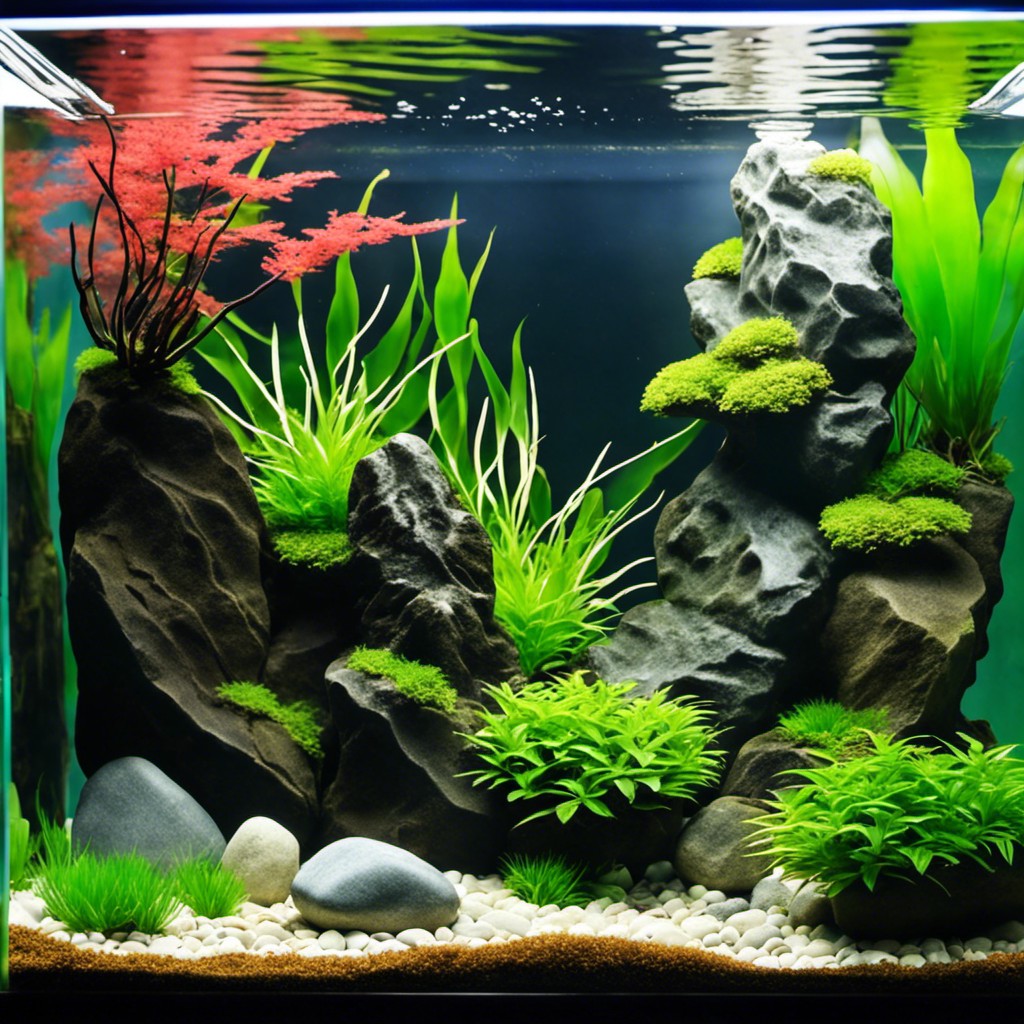
Adopted from the serene elements of Japanese gardening, this style represents a minimalist approach. Designed with an odd number of stones set in a particular manner, it boasts simplicity and understated elegance.
Key points in understanding this are:
- 1. Three or five stones are typically used, with one designated as the main stone. This is the largest and is often placed off-center to create natural asymmetry.
- 2. The remaining stones, secondary, are positioned in relation to the main stone, creating a sense of flow and balance.
- 3. Plant life is minimal in Iwagumi setups and usually consists of low-lying, carpet-like varieties to maintain the focus on stone formations.
- 4. Spacing plays a crucial role in the Iwagumi style. It helps create an open, airy feel while maximizing the aesthetic appeal of the stones.
- 5. Patience is vital. The maturation of an Iwagumi scape can take several months to fully establish and stabilize.
- 6. Maintenance of this setup requires regular trimming of plants and thorough cleaning to preserve its minimalist charm.
Dutch Plant Scaping
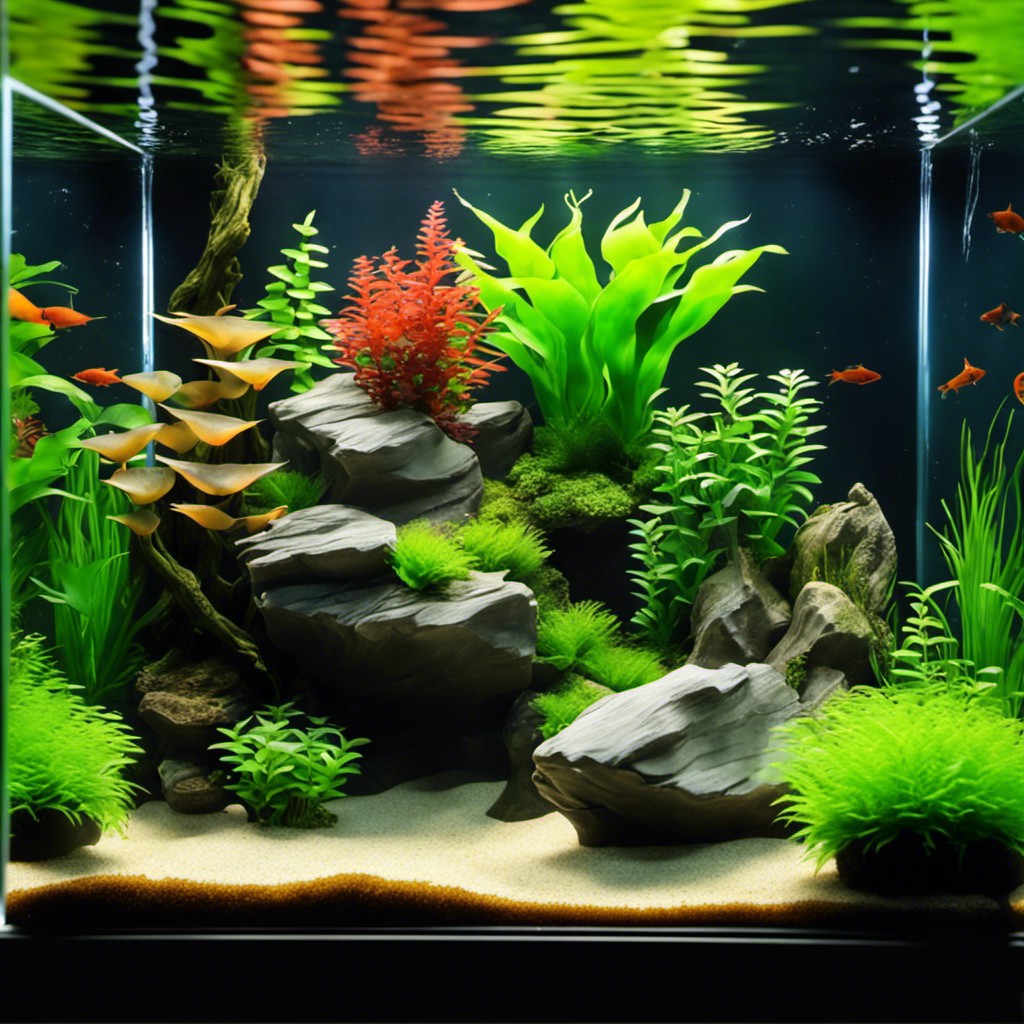
Inspired by the lush landscapes of the Netherlands, this aquascape style livestreams nature into your living space. Expect a vivacious symphony of flora, where differently textured plants are closely planted together to create the perfect patchwork quilt of aquatic vegetation.
Key aspects of this particular style include:
- 1. Variety and Volume: Use multiple types of plants to create a sense of vibrant diversity.
- 2. Order and Organization: Organizing these plants into distinct, well-groomed groups makes your underwater garden visually appealing and prevents it from becoming unruly.
- 3. Height and Hierarchy: Utilize plants of varying heights to add layers of depth and interest. The tallest plants should be at the rear, middle-height in the middle, and shortest in the front.
- 4. Negative Space: Leave some areas unplanted as ‘negative space’; this serves to highlight the aesthetic sweep of your leafy congregation.
- 5. Different colors and textures: Consider plants with distinct leaf types and colors – this will add richness and contrast to your scape.
- 6. Ensure proper lighting, CO2, and nutrient management to help your aquatic garden flourish.
Keep these guidelines in mind and soon your aquarium will transform into a lush, underwater Eden, reminiscent of the verdant Dutch countryside.
Paludarium Setup
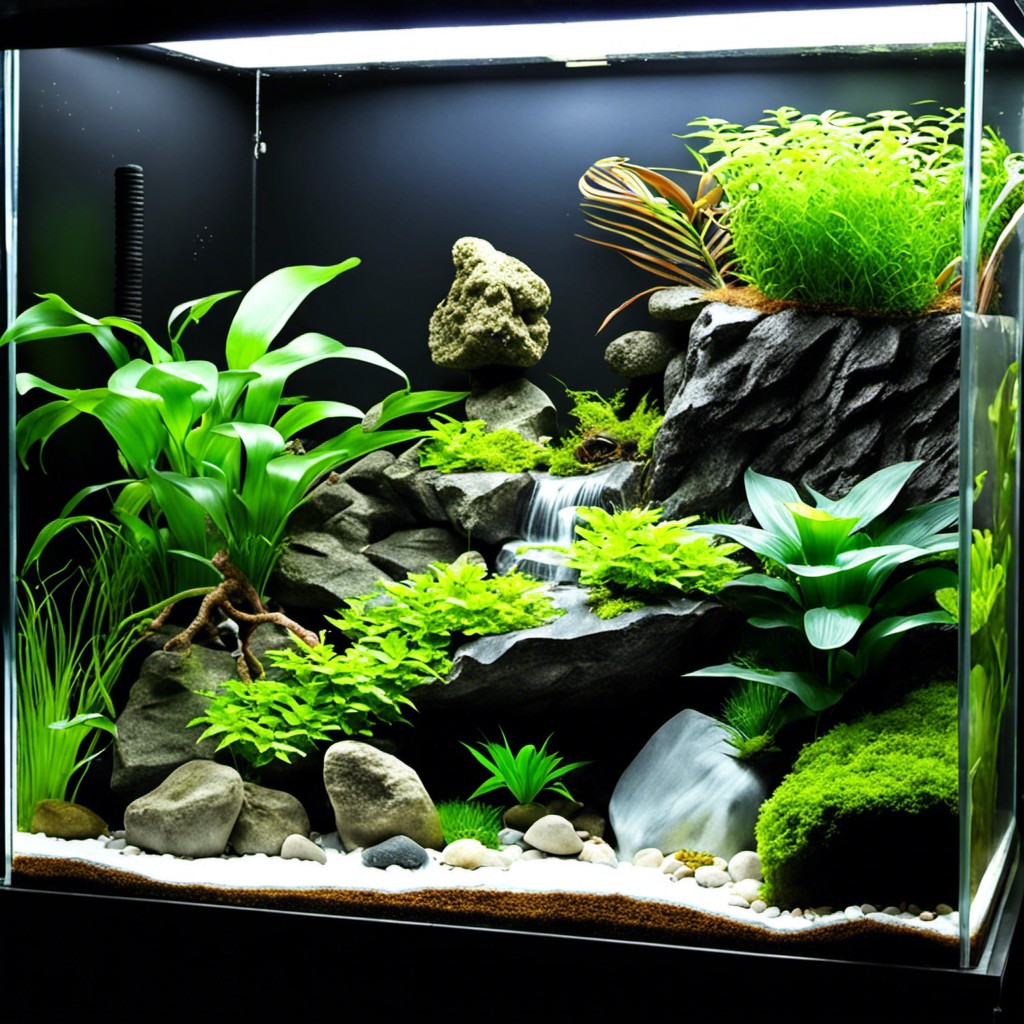
An ethereal blend of terrestrial and aquatic environments, the Paludarium setup stands out due to its distinctive elements. Following are key considerations:
1. Water and Land Areas: You’ll need to demarcate clear water and land sections in the aquarium, with about 60-70% being the water area and the remaining as land.
2. Substrate Selection: For the terrestrial area, opt for substrates that hold moisture well, like coco fiber. For the aquatic part, you can use pebbles or aquatic soil.
3. Plant Variety: Choose both aquatic and terrestrial plant species that thrive in high humidity conditions. Java Fern, Anubias, or Mosses are great choices for underwater greens, while Ferns, Orchids, and Bromeliads can be beautiful terrestrial additions.
4. Animal Inhabitants: Incorporate aquatic creatures like tetras or shrimp, while the land part can house small reptiles or amphibians. Always do research on compatible species.
5. Temperature and Humidity Regulation: Install heaters and monitor humidity levels to mimic tropical ecosystems, as this ensures a thriving, healthy habitat for the inhabitants.
Remember, the beauty of a Paludarium comes from its intricate layering and stunning biodiversity, making it a focal point of any space it adorns.
Biotope Aquarium
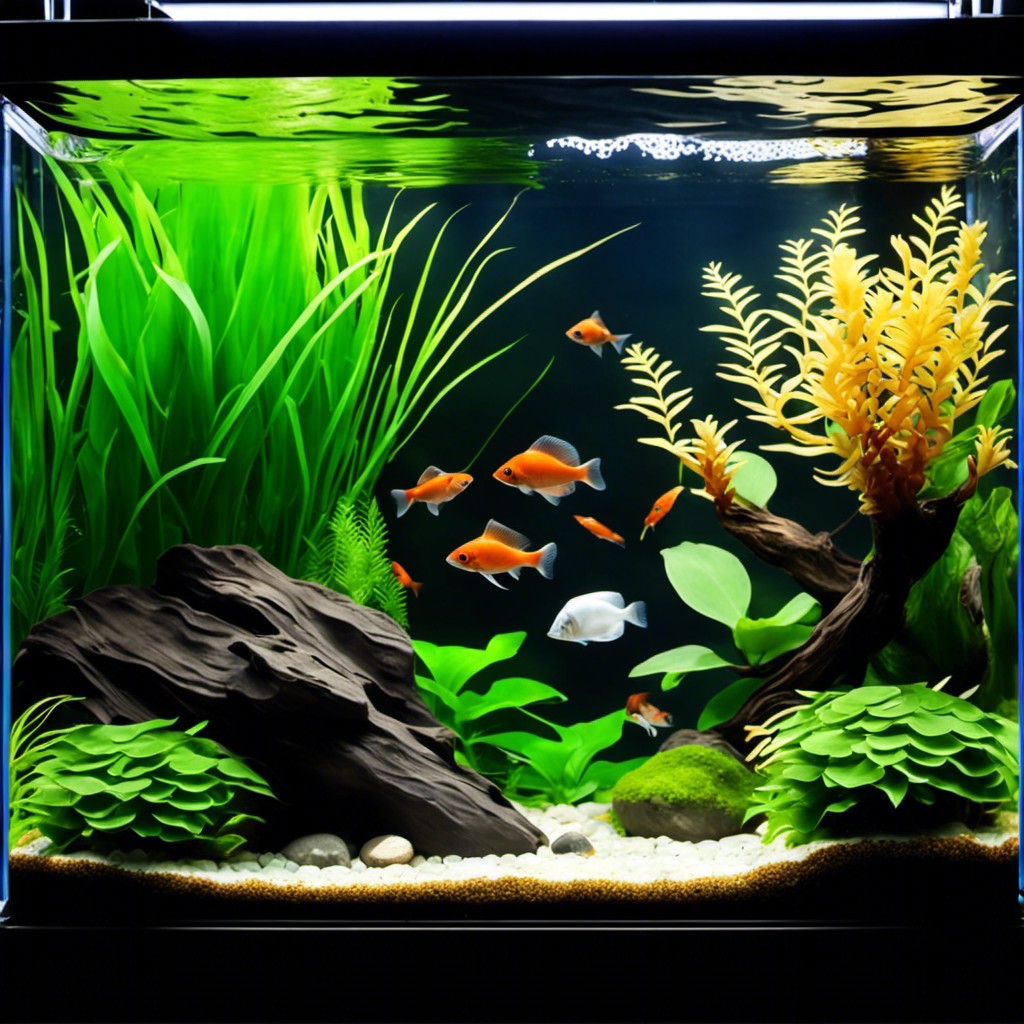
Creating a Biotope aquarium is essentially imitating a specific natural habitat. Your primary goal here is to ensure the plants, fish, and layout work harmoniously, replicating a corner of nature inside your house.
Some vital points to consider are:
- Research: Thoroughly examine the aquatic environment you want to recreate. Identify the appropriate flora, fauna, rocks, and substrate characteristic to this region.
- Authenticity: Remember, fidelity to the original habitat is crucial in a biotope aquarium. This extends to water composition, lighting, temperature, and even the fish’s feeding habits.
- Maintenance: Your chosen habitat will influence maintenance needs. For example, recreating a tropical environment will require more upkeep than a temperate one.
- Eco-Balance: Aim to establish an ecological balance, where your plants and fishes coexist without additional interference.
Remember, the art of aquascaping revolves around patience, creativity, and an ample amount of research. A Biotope aquarium may seem daunting initially, but it allows aquarists to explore different biomes, understanding nature, and creating a thriving microcosm at home.
Jungle Style

Think of a lush, dense plant life – that’s your ticket to a well-crafted Jungle style aquascape. Here, placement, diversity, and layering of vegetation is key. Following some core principles will help shape your verdant water haven:
1. Affluent Plant Life: Aim for an abundant mix of varying plants, the diversification will give the “jungle” feel.
2. Busyness is Key: Unlike other styles, Jungle scape thrives on its dense-looking, haphazard plant arrangement as it mimics an actual jungle.
3. Three-Layers Structure: Mimic nature’s layering by integrating foreground, mid-ground, and background vegetation. This creates depth and emulates the dense feel of a jungle.
4. Wood and Rocks: For that extra jungle vivacity, incorporate driftwood and rocks to offer a sense of wilderness.
5. Overgrown, but Maintained: Let your plants grow freely to achieve that wild look. However, don’t forget to trim and maintain regularly to avoid chaos.
By keeping these tips in mind, you’ll master the art of creating your underwater jungle in no time!
Nano Aquascape
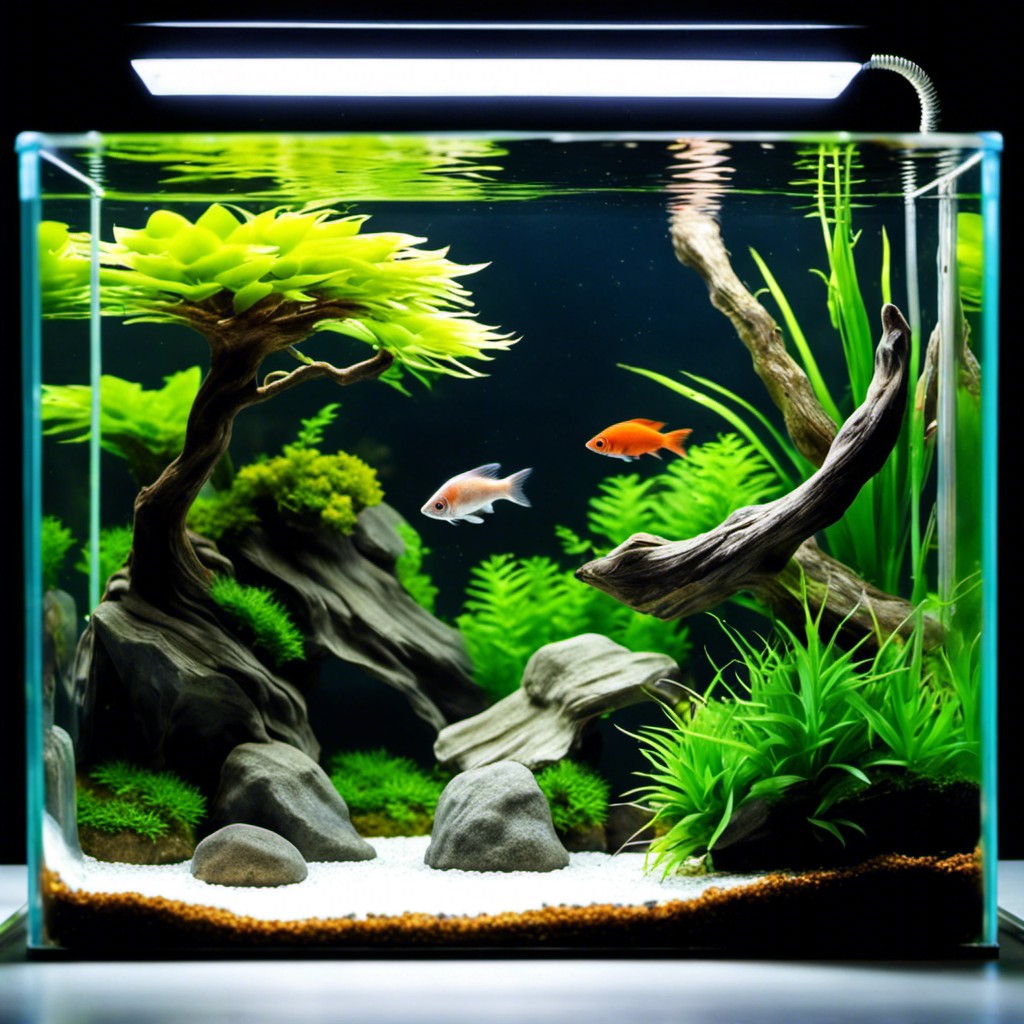
Creating this miniature aquascape requires just as much diligence as actual-sized aquariums. Select the right sized tank, ranging from 5 to 10 gallons. Spruce it up with nano-sized plants like Nano Moss, Anubias Nana, or Pygmy Chain Sword. The focus here is maintaining the proper scale.
Choosing the inhabitants is as essential. Cherry Shrimp, Dwarf Crayfish, or small fish like Galaxy Rasboras thrive well in these settings.
The arrangement of elements should ideally adhere to aquascaping rules such as the golden ratio. Position taller plants or rocks toward the back to create depth, and use the rule of thirds for placement of focal points.
Remember, regular maintenance is vital as smaller tanks can have quick changes in water parameters. A weekly water change and regular pruning will help keep your nano aquascape vibrant and healthy. Additionally, be patient, most aquascapes will fully grow in about 3 to 6 months.
The ‘island’ Layout

Creating an illusion of seclusion, the ‘island’ aquascape involves strategic placement of plants and stones in the center of the tank, surrounded by barren sand or gravel. This solitary focal point can be adorned with different sizes of rocks, driftwood and an assortment of aquatic plants.
Tall plants and larger rocks are preferred for this layout for creating depth, accompanied by moss or shorter plants at the base for an added touch of realism. The space around the island is left vacant, amplifying the aesthetic appeal.
Play around with the island’s shape, it should not be perfectly round. Break its symmetry, in nature, perfect symmetry is a rarity. Use a brighter substrate around the island, this will help to make the island stand out more.
The use of background plants can serve to emphasize the island, giving it a striking, solitary look, enhancing the overall design. This layout offers an invigorating challenge to tacklers, but the architectural and natural result is absolutely rewarding.
Riverbank Replication

For an accurate depiction, choose a sloping substrate designed to mimic river banks. The gradual slope creates visual depth and adds to the aesthetic appeal, making your aquarium more like a real river environment.
Select plant species that thrive well in shallow, flowing water. Popular choices include Anubias, Java Fern, and Vallisneria. Arrange them to follow the slope, shorter plants at the higher end, and taller ones at the bottom.
Select rocks and driftwood carefully to replicate the kind seen on riverbanks. Strategically place these elements to introduce a sense of natural randomness.
Incorporate a powerful filtration system to reproduce the rapid water flow typically found in rivers. Choose fish species such as catfish and minnows that are adapted to living in fast-flowing water bodies. Remember to maintain a cooler temperature compared to a normal aquarium set up to duplicate a river’s cool currents.
Avoiding overcrowding can ensure your design remains close to an authentic riverbank environment. Keeping these points in mind can lead to a satisfying riverbank replication in your own aquarium.
Underwater Garden
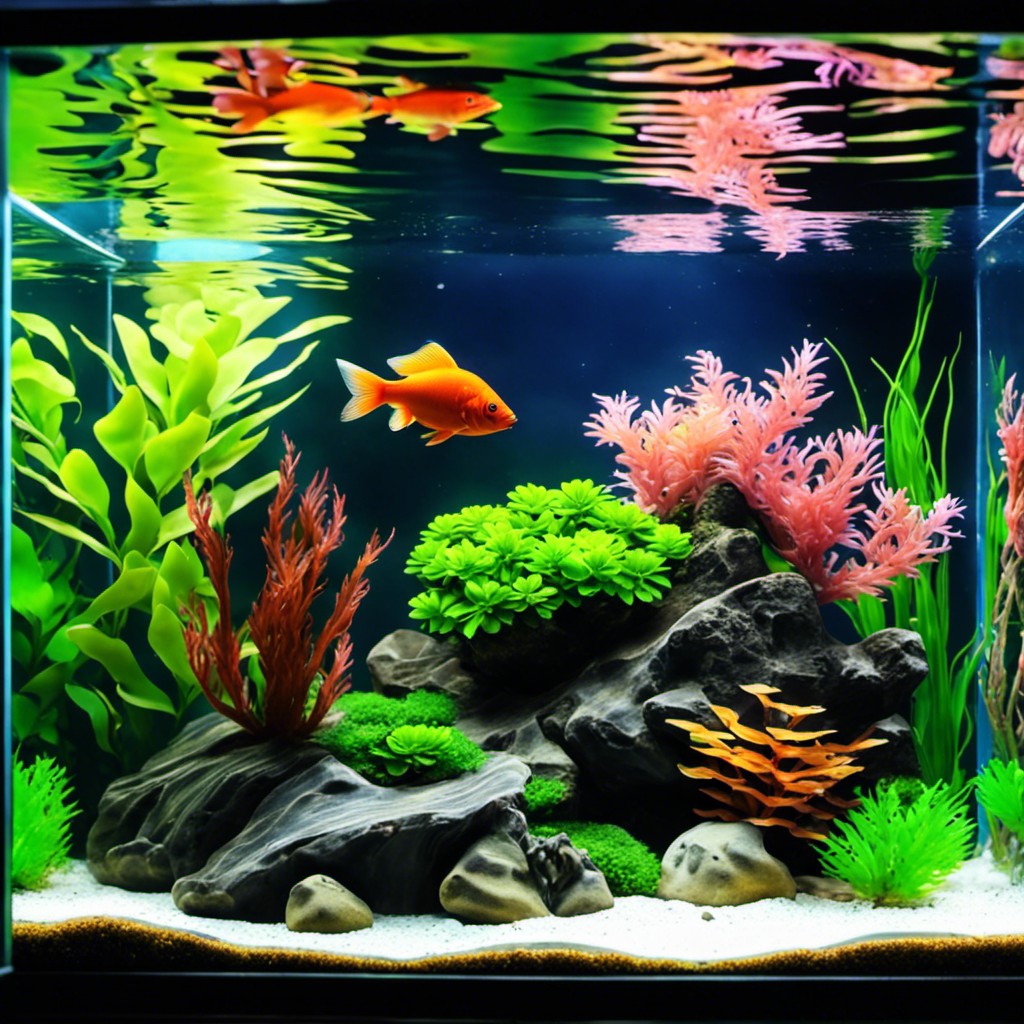
Designing your underwater garden starts with choosing the right plants. Depending on the size of your tank, taller plants like Amazon Swords and Aponogetons work well as a backdrop. In the foreground, include low-growing greens like Dwarf Hairgrass and Anubias.
Next, dedicate time to arrangement and spacing. Mimic nature; disperse plants randomly but with purpose. Group similar plants together for a lush, realistic effect.
Consider adding aquatic animals, like snails or fish, to keep algae in check and add dynamism to your underwater spectacle. Remember to match species with your chosen plants’ needs and the water temperature and pH they thrive in.
Installation of a good quality light is crucial for plant growth. The tank should receive at least eight hours of light daily. Lastly, ongoing maintenance is essential. Regular trimming promotes bushier growth and stops taller plants from overshadowing shorter ones.
Line up your gardening tools – a pair of tongs, scissors, and a curved spatula would be perfect – and you’re ready. Beginning your underwater gardening journey is as exciting as it is rewarding!
Rocky Mountain Layout
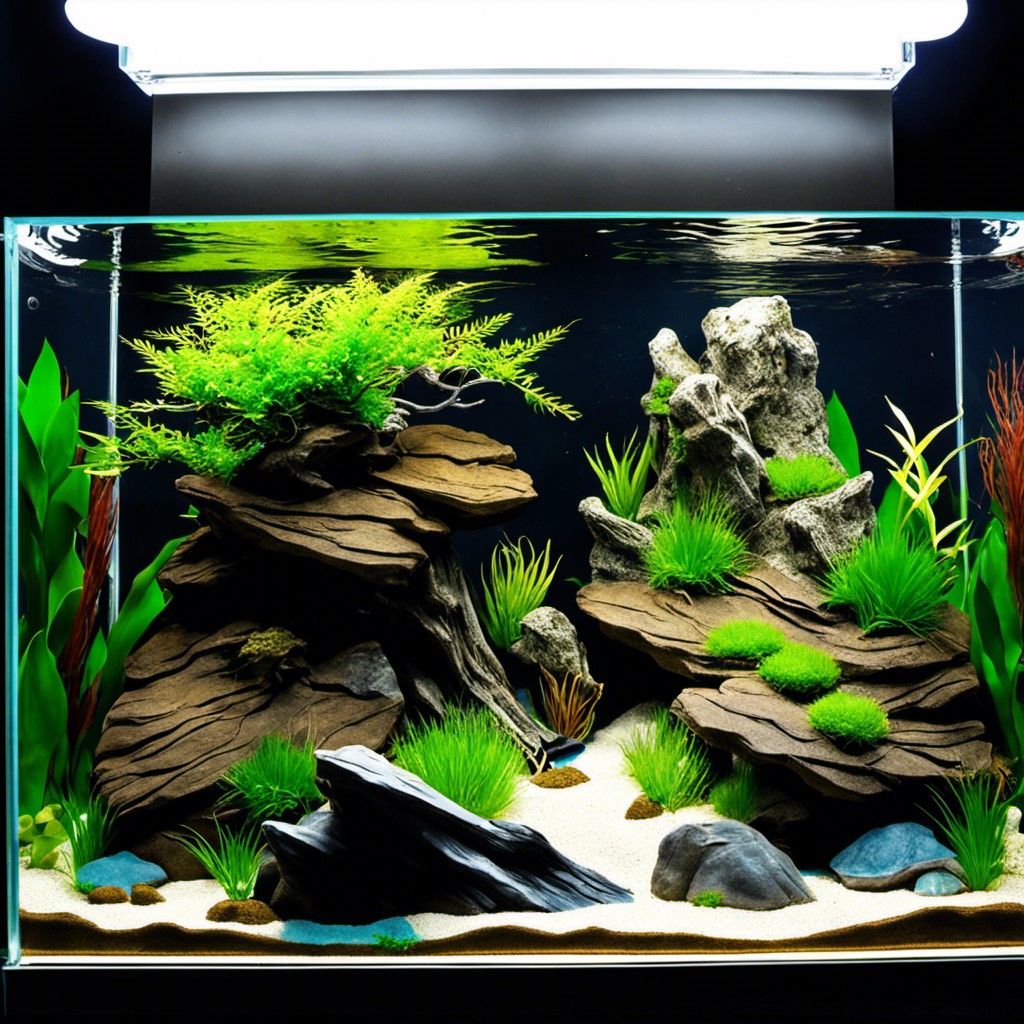
Creating this striking layout involves working with rocks as the centerpiece. Do ensure your rocks are safe for aquatic life before you begin—it’s a must!
Firstly, consider verticality. Position your rocks to mimic a mountain range, gradually decreasing in size as they extend outward from the central focal point. The largest stone, called the “master stone”, positions first, establishing the overall flow.
Subsequently, add smaller rocks, remembering to create a sense of depth through appropriate spacing and positioning them in odd numbers for a natural feel.
Planting plays a significant role too in bringing this layout to life. Choose smaller, low-growing species for the foreground, while taller plants should reside at the back for perspective.
Lastly, consider the use of an aquascaping sand or fine gravel to mimic the look of a rocky mountainside at the base of your arrangement. Play around with the placement until you achieve the desired natural, mountainous look.
Remember, your aquascape is an artwork, take your time, iterate and enjoy the process!
Shrimp Aquascape
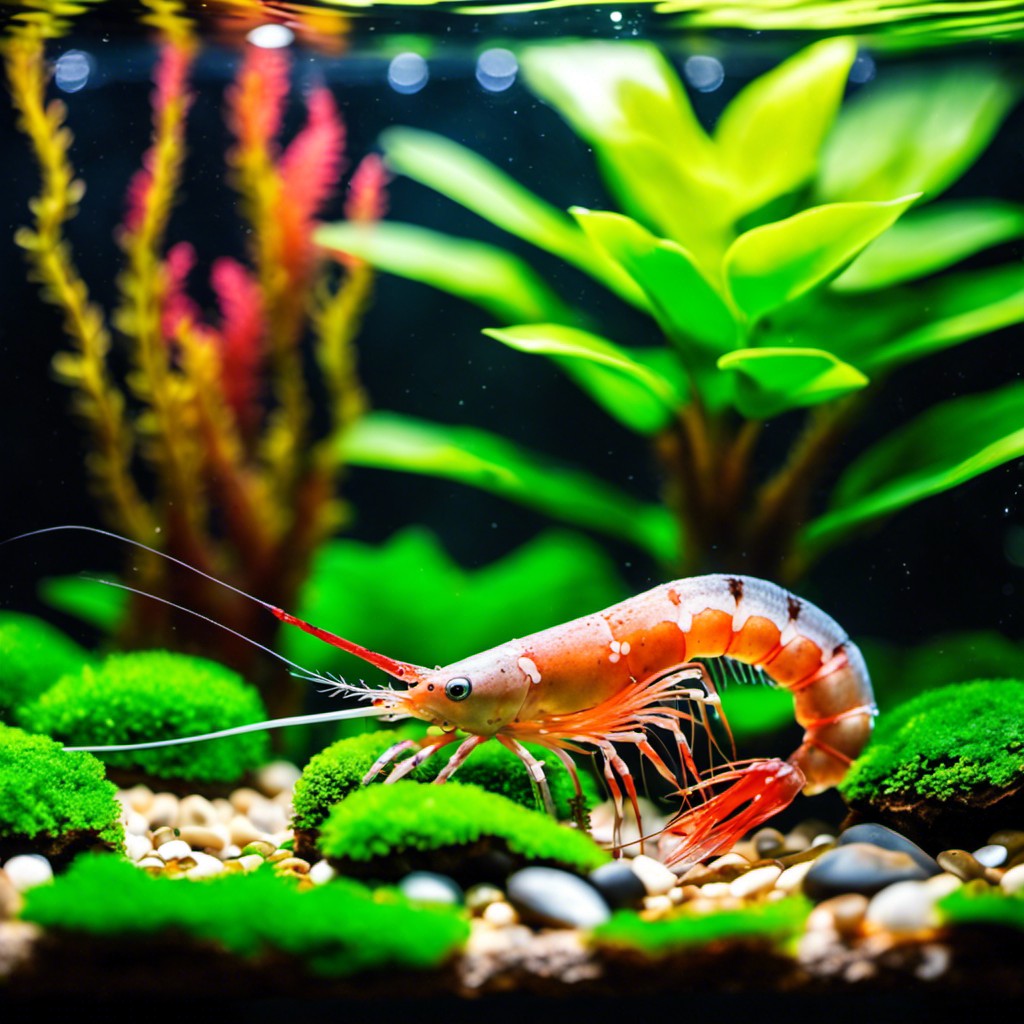
Shrimp aquascapes provide ideal homes for the tiny, vibrant little critters we all adore. It’s essential to ensure it’s not overly complex, allowing for easy navigation and feeding.
Key points to consider:
- Plants: Choose plants that serve as spaces for shrimp to forage, such as Java moss or Anubias.
- Hiding spots: Incorporate small caves or hollow driftwood. Shrimp appreciate sheltered spots, especially during times of stress or molting.
- Substrate: Consider using a nutrient-rich substrate, beneficial for the plants and in turn, your shrimps.
- Water quality: Shrimp, especially dwarf varieties, require clean, well-aerated water, and stable temperatures.
- Size: Small to medium-sized tanks are best suited for shrimp aquascaping. They allow for sufficient space without compromising on the maintenance aspect.
This style is more about recreating a natural, comfortable habitat for the shrimp while creating an attractive, vibrant display.
Remember, always check the compatibility of plants and the shrimp species you plan to keep for a thriving ecosystem.
Terraced Aquascape

Creating a terraced aquascape can merge beauty and functionality in a captivating manner. Here are some key concepts to help you perfect this approach:
1. Layering: Implement varying heights to mimic natural terracing. Lower levels can house small plant species or short decorations, while higher levels can accommodate taller plants or decorations.
2. Substrate Selection: A finer substrate should dominate the lower terraces. Coarser material like gravel and larger rocks can fashion the upper terraces, giving it stability and a realistic look.
3. Elevation and Sloping: Formulating gradual inclines between different levels can provide an arresting visual depth.
4. Plant Positioning: Planting sparse vegetation on higher terraces and denser clusters in the lower area can promote an illusion of further depth, a classic trick in terraced designs.
5. Balance: Equal distribution of plants, stones, and other elements across the terraces will sidestep an overwhelmed or barren look.
6. Maintenance: Constant trimming and upkeep is the key to retaining a terraced layout’s charm over time.
With the right execution, a terraced aquascape can truly add multiple layers of interest to your aquarium.
Pathway Designs
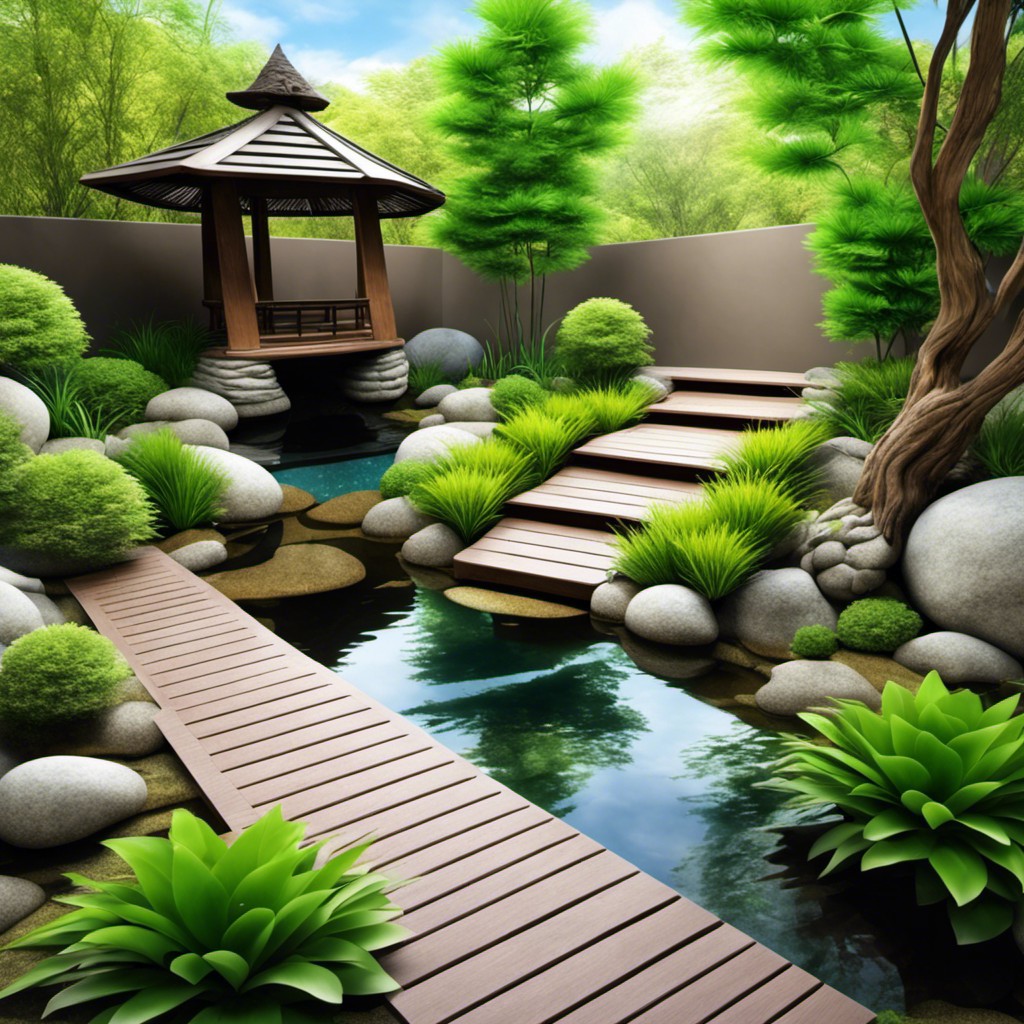
Continuing on to pathway designs in aquascaping, it’s all about creating an engaging, visually dynamic underwater landscape. The key element is the creation of a ‘pathway’ using substrate materials like sand or fine gravel that guides the viewer’s eye through the aquascape.
1. Balance and contrast: Brighter, lighter-colored substrate can provide a sharp contrast to dark or lush green plant life.
2. Illusion of depth: The path narrows towards the back of the aquarium, giving the impression of a longer distance and adding depth to your layout.
3. Strategic Placement of hardscape: Stones, driftwood, and other hardscape elements can be used to border the pathway for a more natural, rugged look.
4. Layering: Gradually increase the height of the substrate from front to back, enhancing depth perception.
Remember, less can often be more when it comes to pathway designs. The pathway should not overpower the overall balance of the aquascape but rather complement it harmoniously. It’s all about finding the right equilibrium between all of the design elements.
Bonsai Tree Aquascape
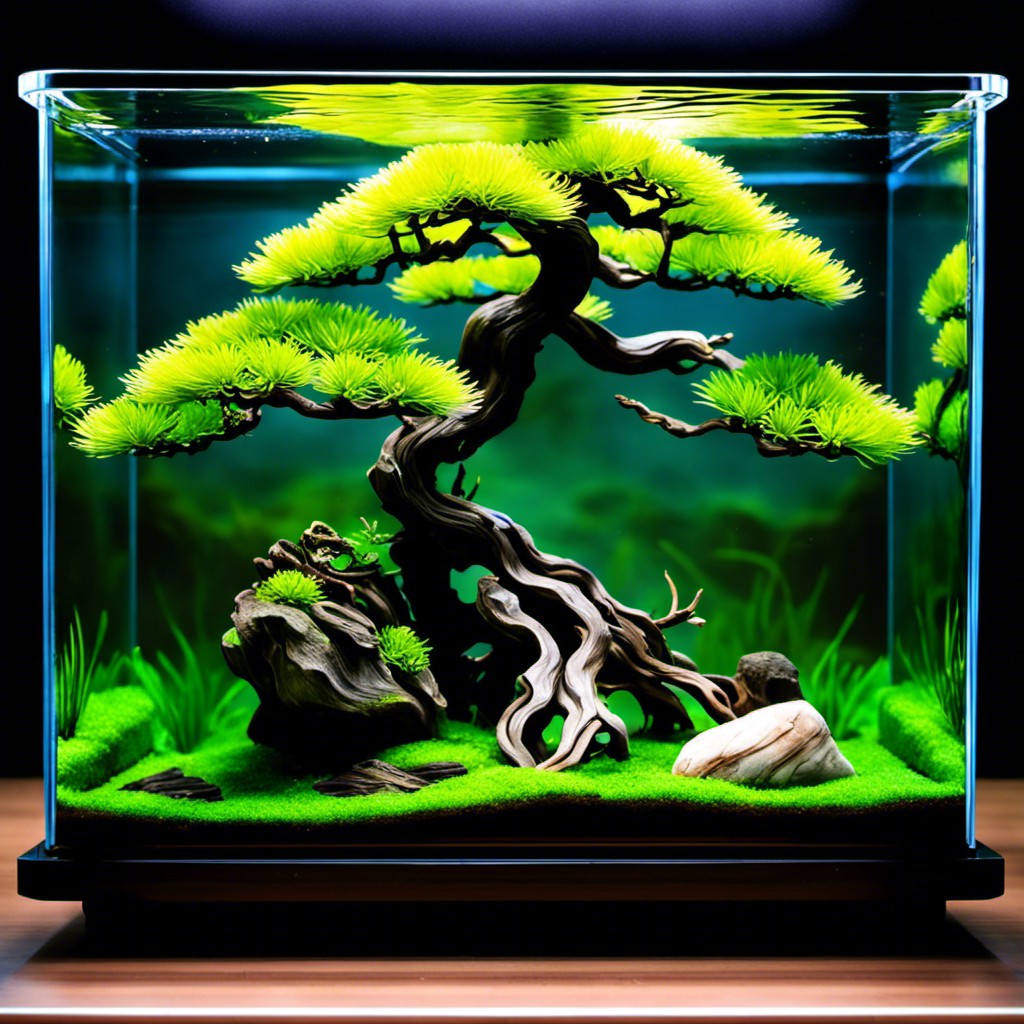
To start off your very own bonsai tree aquascape, you can use real or artificial bonsai trees. The choice largely depends on the level of maintenance you’re ready to take on. Real bonsai trees offer natural authenticity, though they require diligent care. On the other hand, faux options are effortless and still give that Zen aesthetic.
Particularly intriguing is the sense of depth created in this layout. You’ll want to provide visual focus on the tree, arranging it conventionally at a non-central point. The rule of thirds is a good guiding principle to make your layout visually appealing.
Submerged bonsai trees can transform any aquarium into an enchanting underwater forest. Small rocks, sand, or aquatic moss can mimic the grassy landscape of a terrestrial forest. Additionally, the addition of other aquatic plants around the base can give a feel of shrunken environment.
Last but certainly not least, consider the fish. Small, bright fish subtly highlight the bonsai without stealing the show. Go for species that won’t nibble on your underwater vegetation, maintaining the health and aesthetics of your design.
In the end, it’s about instilling tranquillity and offering an homey ecosystem for your aquatic pets. After all, the beauty of aquascaping lies in blending artistry and biology into a functional, breathtaking underwater scene.
Dense Forest Layout
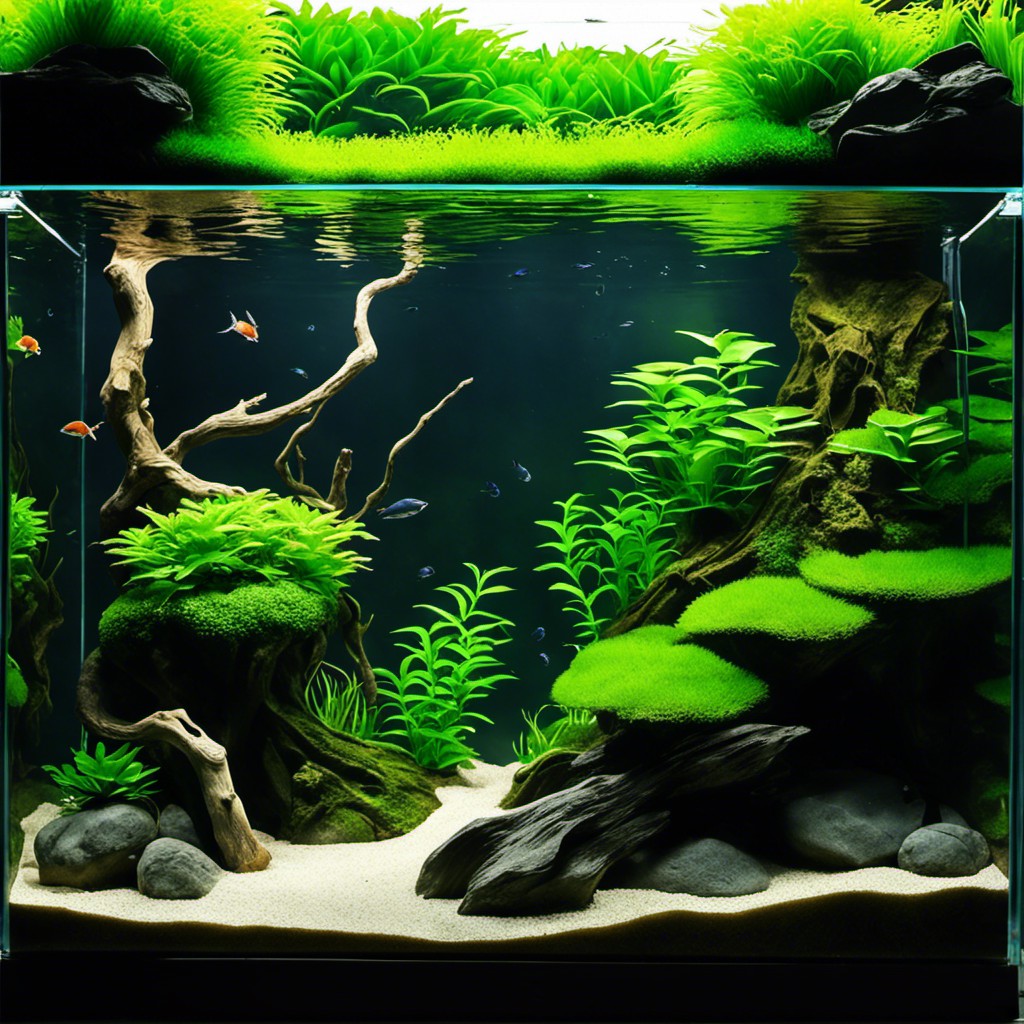
The magic of the dense forest layout lies in its grandeur and complexity. Mimicking a real, wild forest floor, this style captivates its observer with thick greenery, towering aquatic plants, and strategically placed driftwood representing ancient fallen trees.
Let’s break down the essentials.
- Plant Selection: Opt for diverse plant varieties like Anubias or Bucephalandra that thrive in medium lighting and provide eye-catching textures.
- Driftwood Placement: Create an authentic forest landscape with creatively arranged pieces. It should seem like the plants have naturally sprouted around the driftwood, shaping your underwater forest.
- Layering: Design different layers to give your forest depth. Use moss for the forest floor, medium-sized plants for the middle layer, and tall plants to imitate towering trees.
- Lighting: Adjust your tank lighting to mimic the dappled sunlight of a real forest. A darker forest floor and brighter upper layers can create an engaging, realistic effect.
Remember, patience is key as dense forest layouts take time to reach their peak. But rest assured, the wait is entirely worth it.
The ‘valley’ Design

Creating a ‘valley’ in your aquascape injects a captivating aspect of depth and perspective into your layout. The key is positioning – taper your aquatic plants or stones from tallest at the edges to shortest in the middle, forming an inverted V shape or a valley. Ensure the materials used for this venture work in harmony. Stones or driftwood can serve as defining markers for the valley borders.
Utilize small, delicate plants as the valley base, and use larger, bushier plants for the sides. Remember, the illusion of depth is further enhanced by using plants with smaller leaves in the middle and larger leaves by the sides.
Lighting plays a crucial role. Set up a dim lighting arrangement in the middle, with brighter lights at either end to increase the sense of depth and distance.
The added benefit of a valley design is its likeness to a natural riverbed. You can go a step further by adding sand in the middle for an authentic riverbed look. Never underestimate the impact of a strong aesthetic, it can make visitors forgive even the smallest tank.
Mossy Cavern Design
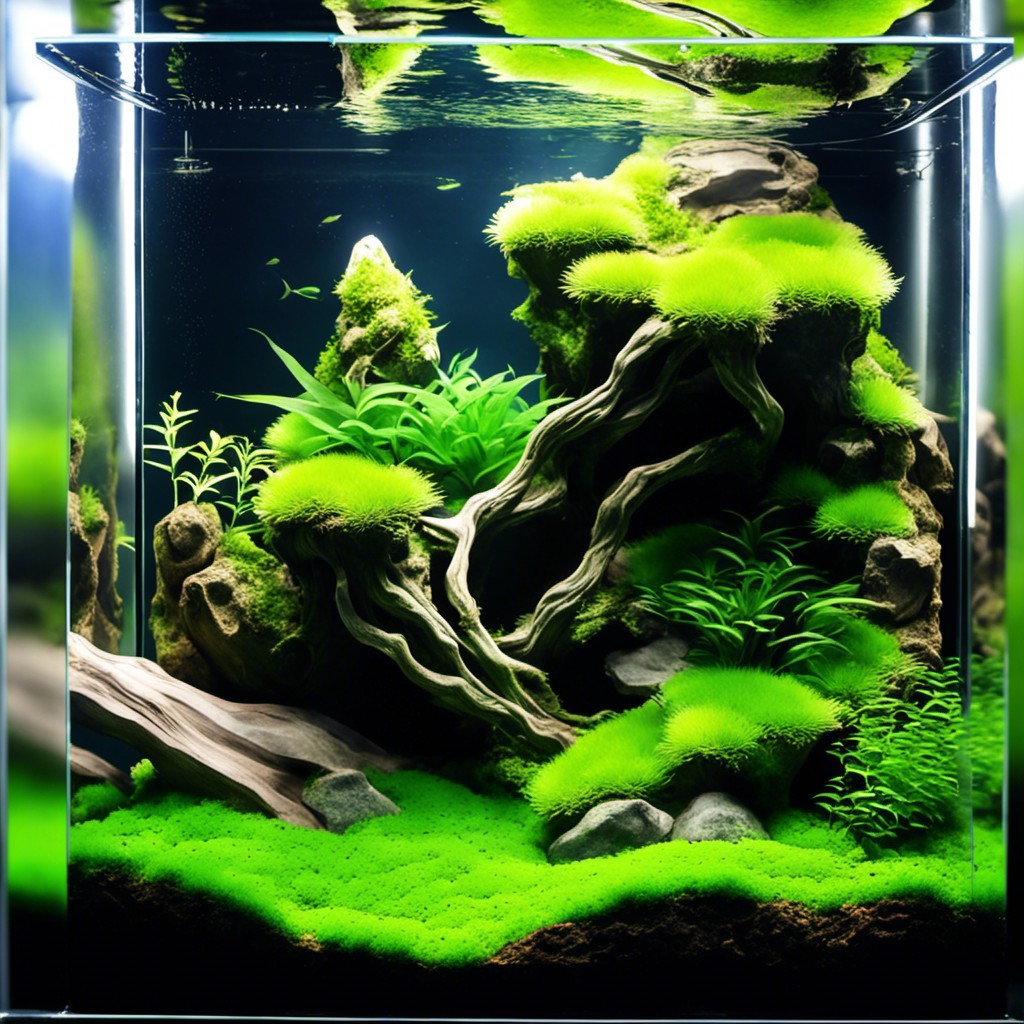
Creating a Mossy cavern design necessitates strategic planning and placement. Start with a focus on hardscape using rocks and wood to form the cavern structure, ensuring there’s plenty of room for plants and fish to navigate. Opt for porous rocks, which offer a perfect surface for moss propagation.
Java Moss is a cost-effective and popular choice for this style with its soft, lush aesthetic and easy maintenance. Maintain good water quality, but don’t worry too much about lighting – moss thrives in low light conditions. Achieve a realistic, textured look by layering moss at various depths throughout the cavern.
Regular maintenance is essential. Trim your moss frequently to preserve the cavern shape and prevent overgrowth. Balance is key in aquascaping, and with some patience and creativity, you can create an enchanting underwater cavern without breaking the bank.
Remember to carefully choose fish and other aquatic creatures that enjoy environments similar to mossy caves. This harmonious environment setup will not only create an appealing aesthetic but also promote a healthy ecosystem.
Stonehenge Replication
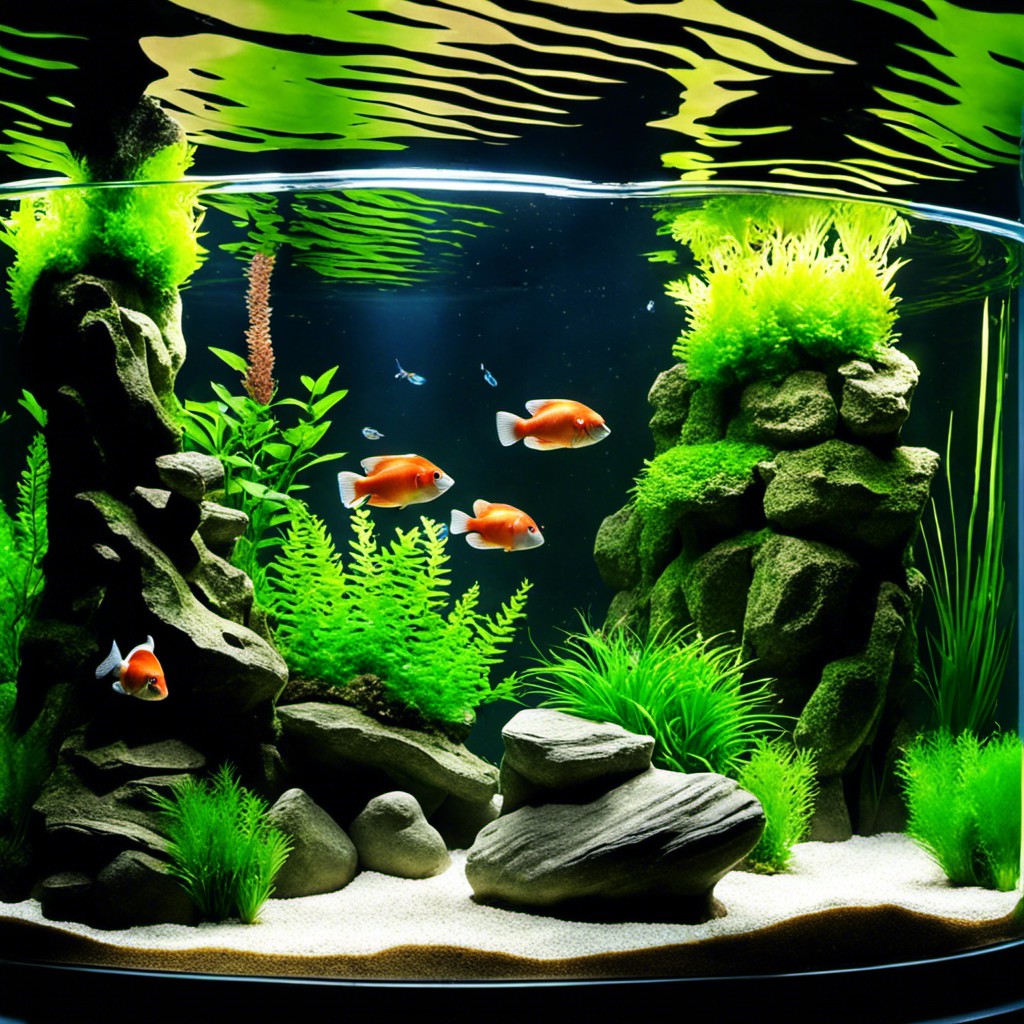
Crafting a Stonehenge replication aquascape requires three primary elements: levelling, stone selection, and plant placement.
First, evenly leveling the aquarium’s substrate maintains stability and accentuates the standing stones’ prominence. This step lays the foundation for your aquatic masterpiece.
Second, choosing the right stones is imperative. Dense, easily stackable stones are suitable, like Seiryu or Dragon stones. Remember, the idea is to recreate the elusive, ancient charm of Stonehenge. Aim for a circle or horseshoe arrangement to mirror the real-life monument.
Last, sparsely distribute plants to not distract from the stone structure. Low-maintenance plants, like Java moss or Dwarf Hairgrass, are ideal choices. These species subtly frame the stone structure and add a whisper of life without overpowering the scene.
Commit to these basic principles for a breathtaking Stonehenge aquascape. This method is a compelling approach to evoke a sense of ancient mystery in your home aquarium.
Coral Reef Aquascape
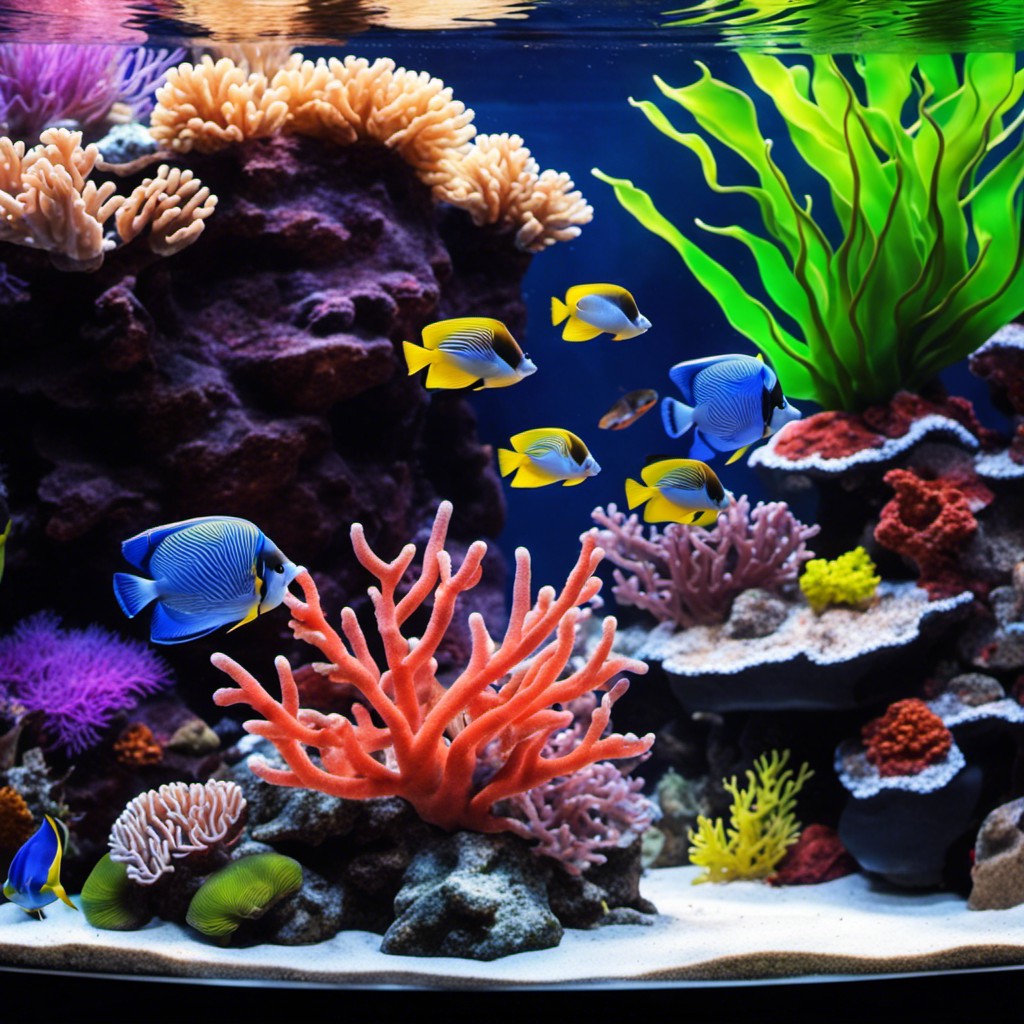
With a nod to marine lovers, taking on a coral reef aquascape can be a rewarding challenge. Essentially, this configuration attempts to mimic the colorful dynamism and diversity of life present in a real-life oceanic coral reef.
1. Variety of species: Embrace an array of vibrant, coral species, such as Zoanthids, Mushroom corals, and Neon Green Star Polyps to replicate that ubiquitous riot of color.
2. Visual complexity: Arrange rocks skillfully to mirror the complex formations of natural coral reefs, creating ledges, caves, and hideouts for the fish. This also lends depth to the aquascape.
3. Lighting: Lighting is crucial for the health of your corals. Incorporating strong, bright lights accentuates the corals’ colors and ensures their photosynthetic requirements are met.
4. Flow and filtration: Coral reefs need powerful water flow and robust filtration. Not only do these mimic natural marine current but also help the corals filter feed.
5. Saltwater inhabitants: Populate your tank with a plethora of marine life such as clownfish, gobies, or butterflyfish. Additionally, invertebrates like shrimps and crabs add authenticity.
Rainforest Emulation
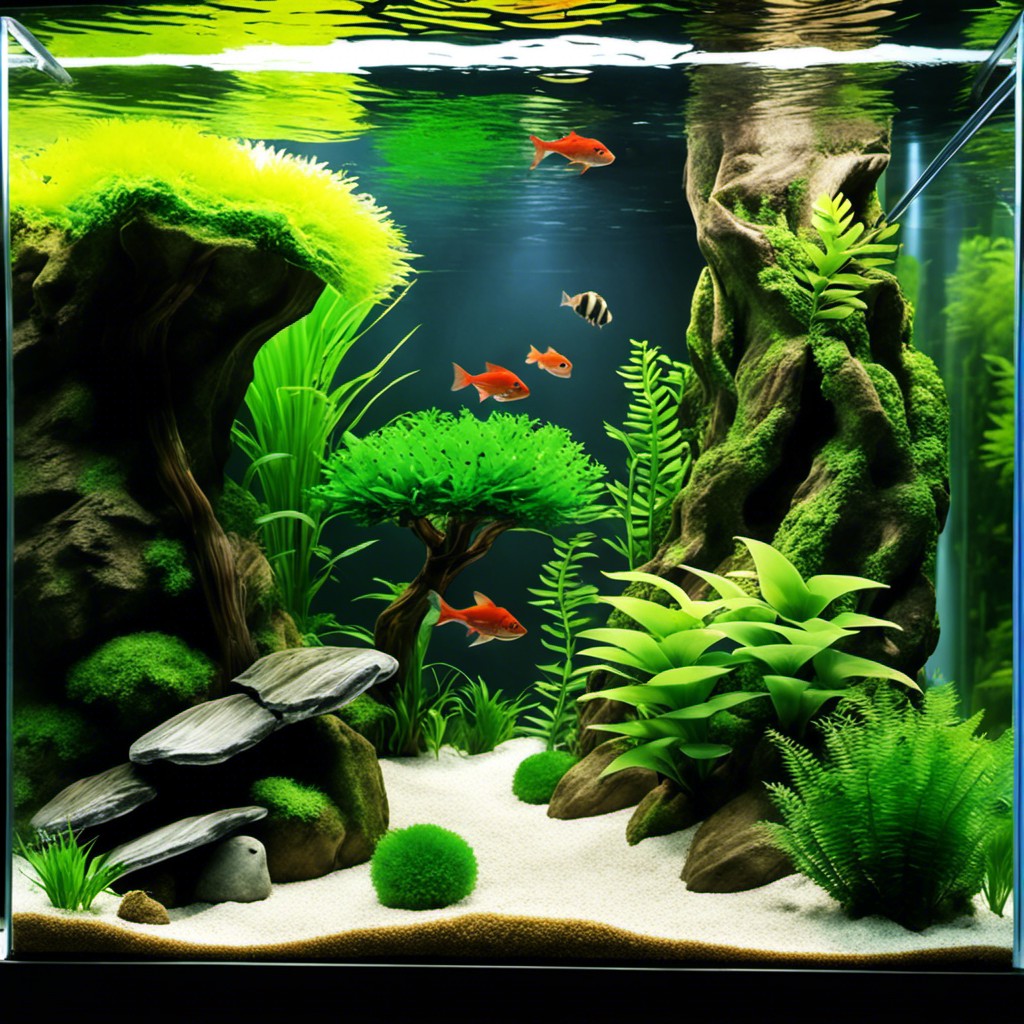
To achieve a rainforest emulation, focus on the elements that define this lush, dense environment.
1. Select Flora: Opt for plants with large, voluminous leaves and rich green coloring. Use a mix of different species to mimic the diversity found in an actual rainforest. Plants such as Amazon Swords or Java Ferns are great choices.
2. Layering: Create different layers – with a canopy layer on top, an understory layer in the middle, and a forest floor at the bottom. This adds depth, dimension, and interest to your design.
3. Use of Wood: Incorporate driftwood or vines to serve as tree trunks and branches, providing vertical dimensions.
4. Hardscape: A natural-looking substrate mimicking forest floor, like small gravel or sand, build the perfect hardscape look.
5. Animal Life: Small fish species and invertebrates contribute to the design’s authenticity and act as the rainforest’s inhabitants.
6. Lighting: Soft lighting is key to create shadowy areas, mimicking sunlight filtering through a dense rainforest canopy.
7. Maintenance: It might get bushy as the flora grows, do trimming regularly to keep the desired aesthetic.
Remember, patience is essential when it comes to aquascaping, as the design evolves over time to its full potential.
Recap


